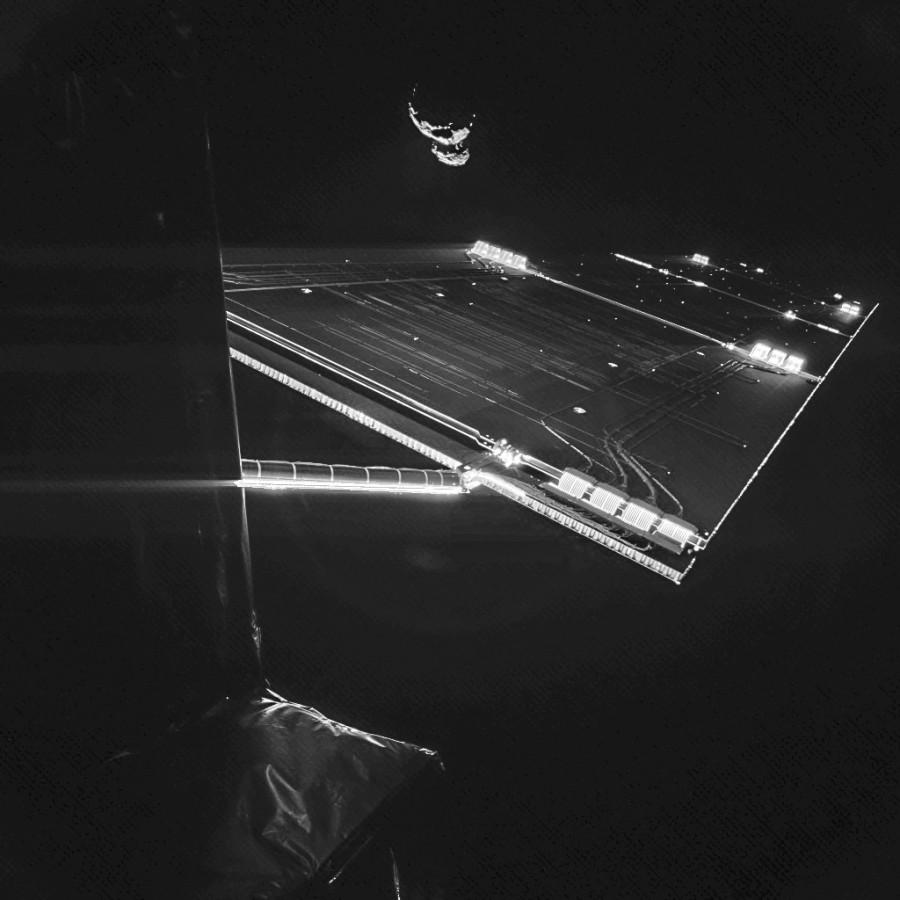World at a Glance: Japan Launches New Jet, Russia Invades, Mankind Lands on Comet
Above is a photo that the German satellite Rosetta took of the comet 67P that it is now orbiting. A probe sent from Rosetta was launched on November 12 and has landed on the surface.
November 14, 2014
Japan Launches First New Commercial Aircraft in 50 Years
After more than 50 years, the Japanese are about to release a brand new passenger jet set to launch into service in 2017. The last commercial aircraft Japan produced was the Mitsubishi YS-11, a turboprop that was hoped to revive the manufacturing industry in Japan. But after 10 years, from 1962 to 1972, only 180 were sold.
This new passenger aircraft is called the Mitsubishi MJR, the Mitsubishi Regional Jet. The development of the aircraft began in 2008 and since the beginning it has had to overcome numerous problems in the production process, but Hideake Omiya, the chairman of Mitsubishi, is confident that the company’s new jet can perform in the modern world.
Omiya’s confidence was evident at the launch event: “We had to be prepared to bear the risk that could jeopardize our company’s foundation. Going forward this jet will fly to every corner of the world. This is the moment of dreams come true.” The airline ANA is the launch customer of the new aircraft ordering 15 new jets. Other launch customers include JAL (Japan Air Lines), Air Mandalay, Sky West, Trans States, and Eastern Airlines.
The aircraft will have two versions, one with 70 seats and another with 90 seats. It will cost $42 million and has a range of up to 1,820 miles. Its first flight is scheduled for next year.
Russian Troops Invade Ukraine
Two months after a cease fire agreement Russian troops and vehicles are advancing freely across the border into Ukraine. The agreement has fallen apart and the Ukraine is in the midst of an invasion. Russia has officially denied involvement in the conflict but the truthfulness of that statement is in serious question. Since Saturday, November 8th, 126 vehicles in total have been spotted in land controlled by pro-Russian rebels who call themselves the Donetsk People’s Republic.
Tensions between Russia and NATO are at an all time high since this conflict began. Sanctions have been imposed by the U.S. and U.N. but they seem to be having little effect on the conflict. NATO official Gen. Philip M. Breedlove has said he is “concerned about convoys of trucks taking artillery and supplies into east Ukraine from Russia.” Russian forces are in combat with Ukraine and are reported to be training the rebels with Russian equipment.
The U.N. Security Council held its 26th emergency meeting to discuss the escalation of the Russia-Ukraine engagement. Officials expressed fear of long-lasting destabilization in Ukraine that could last for decades afterwards.
Victims of this conflict include the passengers of Malaysia Flight 17 from Amsterdam to Kuala Lumpur. The Boeing 777 was reportedly shot down over Western Ukraine by the pro-Russian rebels. This event brought the engagement more worldwide attention and has contributed to distrust towards President Putin in Moscow.
Rosetta Spacecraft Lands on Comet 67P, A First in Human History
Another giant leap for mankind was made on November 12th when a German satellite called Rosetta launched a probe that landed on the surface of comet 67P. The satellite Rosetta launched on March 2, 2004 and has used the gravitational pulls from Earth and Mars to accelerate and reach the comet. The mission cost 1.3 billion Euros or $1.6 billion.
In 2005 Rosetta used Earth’s gravity to slingshot itself through space to Mars. When it reached Mars in 2007, it used the gravity from Mars to slingshot itself again into space. Using the gravity of Earth and Mars was necessary because the comet is traveling at 24,500 miles per hour (6.8 miles per second), far faster than any spacecraft can currently travel.
After flying by the comet Lutetia in 2010, Rosetta went into a programmed hibernation which lasted until early 2014 where it came back online. Then on November 12th Rosetta launched a probe that successfully landed on comet 67P. The probe reportedly bounced when its harpoon didn’t deploy properly. The low gravitational pull of the comet, only 2.5 miles wide, made landing very difficult and what the Germans would describe as the act of trying to land on a speeding bullet.
The probe is now safely on the comet after ten years in space during which it circled the sun three times and is now 317 million miles from Earth. The long distance meant that the radio signal confirming the landing took 28 minutes to reach Earth. To put that distance in perspective, the moon is 238,900 miles away and the minimum distance to Mars is 33.9 million miles while the maximum distance is 249 million miles.
Photo Source: https://www.flickr.com/photos/europeanspaceagency/15012675360





